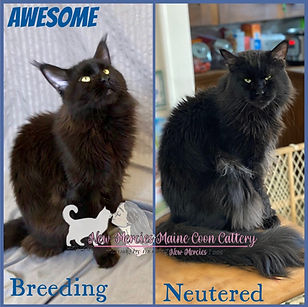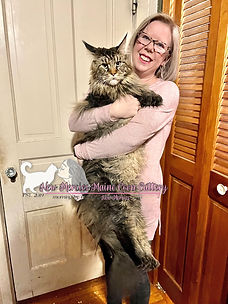
Breeding stunning Maine Coon Cats for health, temperament, and joy
General Information on Maine Coon Cats
Maine Coons are one of the friendliest and fun-loving cats there is. Often they are called “the dogs of the cat world”. As they prance around with their tail high in the air, there is no missing this large, beautiful cat.
Maine Coons are one of the largest domestic cat. Males typically weight between 15-20lbs and stand 10-16in high. Females typically weight between 10-15lbs and stand 8-14in high. Both males and females are anywhere between 30-40in long. They are a slow-growing breed, so a Maine Coon Cat will not reach his/her full potential until they are about 5 years of age.
The Maine Coon coat is long and fluffy. They have a full mane, long bushy tail, and when you look at them from behind they appear to be wearing pants. A classic Maine Coon trait is the ear tuffs stick straight up from the top the the ears, as well as tuffs of fur on the bottom of the feet.
Because of their long, thick coat, Maine Coons require daily brushing. Nails will also need to be clipped, but scratching posts that are easily accessible to the cat will help you.
Purebred or Pedigreed?
Most people use the word "purebred" to describe a cat that is registered and "doesn't have any other breed of cat in their genetic history". However, there is no such thing as a "purebred" cat if that is your definition. Cat are not like dogs in that you can trace only dogs of their same breed almost as far back as you can go. With cats, there are generally many different breeds of cats in a "purebred" cat's history. This is how features of specific cat breeds are born.
The better word to use for a "purebred" cat is "pedigreed". Pedigreed means that the cat is registered with one of the big cat associations such as TICA or CFA here in the US. In order to register a cat with one of these associations, the cat must have only their breed of cat in their ancestry for at least 5 generations back. This must be proved with a certified 5 generation pedigree from one of the accepted cat associations from around the world. (This is how I register the cats that I import from Russia, who are registered with a Russian association, with TICA). Anyone can say that their cat is a "purebred", but that doesn't mean anything if they do not have the pedigree to back it up.
So from now on when you are looking for a "purebred" Maine Coon to add to your family, you can now use the word "pedigreed" to ensure you are getting exactly what you want and won't get scammed.
In the world of purebred cats, each breed and color has an international code. That way no matter where a cat is born, he/she will be the same color and pattern in every country. This is called the EMS or FIFE system.
Maine Coon Cats' international code is MCO. Colors are listed as a lower case letter(s) followed by a number. The number tells which tabby pattern the cat has, as there are 5 different types of tabby patterns. A single lower case letter means the cat is a solid color, and a lower case letter with a "s" after it means the cat is a smoke. If you visit any of the pages under the "Pictures" drop down menu, all of my cats and kittens listed there have their EMS code listed.
A big question everyone wants to know is, are Maine Coons good with children. The short answer is yes!
Because Maine Coons are a gentler breed of cat, they tend to do better with children and tolerate them better. However, as with any animal, their personality, genetics and way they were raised plays a part in it. When you are looking for a Maine Coon as a family cat, you want to make sure their parents had a wonderful temperament, and that they were raised with children, or at least make sure they were not raised in a quiet home with very little activity. That is the first step to helping your family and new kitten succeed.
Here at New Mercies Maine Coon Cattery, our kittens are raised with children in a busy home. They are use to hearing noise and commotion right from birth. Then they begin being handled by our children at a young age. Our children are a vital part of our kitten raising team, so when your kitten joins your home he/she is ready to love your children as well!
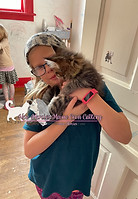

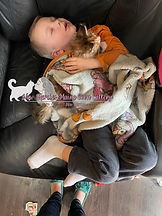
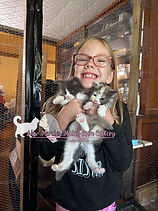
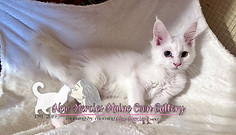
The Genetics of a White Cat
The genetics of a solid white cat is confusing and fascinating! White cats are actually not truly white. Rather, they have a gene that masks their true color and pattern, making them appear completely white. When you breed a white cat, you can then begin to figure out what color they are masking. Some of their kittens will in fact be white, but others in the litter will not be. From those kittens showing a pattern, you can then start to figure out what color the white parent is masking.
Eye color is also different with a solid white cat. While they can have the normal green, copper or yellow eyes, they also can have blue eyes or odd eyes. (Odd eyes is when the cat has one blue eye and the other eye is green, copper or yellow).
Some what cats can also be deaf. The chance of being deaf is also increased if the cat has blue or odd eyes. For more information on this, you can click here to visit our health page.
Polydactyls
Polydactyl cats - also called polys, have a long history. They are sometimes referred to as Hemingway Cats, as Hemingway owned several of them. But many other famous people throughout history have owned polydactyl cats.
Polydactyl simply means extra toes. All cats have 5 toes, but a poly will have anywhere from 6-8 toes on a single paw. Another interesting fact about polys is that they do not always have the same number of toes on each paw! The front paws or back paws always have the same number of toes, but the front paws could have more or less toes than the back paws.
Being polydactyl does not pose any problems or health concerns for the cat. They are not prone to problems with their paws, and being poly is not linked to any health related problems. The only problem you may have with a poly cat is that they can get into much more trouble! Polys can use those extra toes to get into (or out of) things a "normal" cat can't. We have even heard of them turning door knobs! There is some debate in the breeding world if breeding a poly male and female together is ethical. Some breeders swear the double poly gene does create problems with their kitten's paws. Other breeders say there is no issue at all with kittens from 2 poly parents. While this is still under debate in the breeding world, we will not be breeding 2 poly cats together, just to stay on the safe side.

Male Cats Spraying
I have many people concerned about their male kitten spraying if they wait until 6 months to neuter him. But spraying is something most people are vastly uninformed about. Yes, most male cats spray if they are not neutered. However, spraying is an instinctual habit driven by the desire to breed. This will not happen until the male has reached sexual maturity and his breeding drive has fully kicked in. The likelihood of your male kitten spraying before he turns a year old is very small. Therefore, you will be perfectly safe to wait until your male kitten is even 10 months old to have him neutered. Click here for more information on what you can expect from your male kitten.
Grooming
Grooming is a must for Maine Coons due to their long, thick hair. Some Maine Coons need more grooming than others, but none the less, every one needs some level of grooming. To do this there are multiple different tools out there, but what we find works the best is just a simple, metal, wide-toothed comb. There are also tools out there for helping to get mats out. However, be careful as some tools could damage the undercoat of your kitten. Furminators are a popular brush style, but not necessarily the best for a Maine Coon. On my Recommended Supply List you can find links to some good grooming tools that we use.
We do not bath our Maine Coons.
Why don't all Maine Coons look the same?
Just like people, Maine Coons come in all different shapes, sizes, color and have different bone structure, all dependent on genetics and ancestors.
There are two main kinds of Maine Coons, European and American. The European Maine Coons tend to have a more “wild” look to their face and strong bone structure. The American Maine Coons tend to have a more sweet and softer look. These two kinds of Maine Coons can have very different looks and still fall within the Breed Standard.
Time of the year has a lot to do with their look as well. In the winter months their fur tends to be thick with full, beautiful manes. In the spring these coats are shed and sometimes can almost look like a short haired cat. However, their tail, ear and feet tuffs should remain all year long. But even their tail can shed and become very short at times.
Maine Coons in breeding programs also can have a very different look than Maine Coons that are spayed/neutered. Breeding Maine Coons tend to be skinner and have shorter fur because their energy is going towards reproduction instead of being stored. Here is a pictures of Awesome help to illustrate the point. These 2 pictures were taken less than a year apart, yet there is a pretty significant difference.
